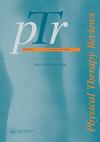What elements of the exercise prescription process should clinicians consider when prescribing exercise for musculoskeletal rehabilitation in a one on one setting? A review of the literature and primer for exercise prescription
IF 0.8
Q4 REHABILITATION
引用次数: 1
Abstract
Abstract Background Despite exercise being a fundamental component of musculoskeletal rehabilitation, there is a lack concise, evidence-based recommendations to inform the clinician’s development of rehabilitative exercise programs for patients in a one-on-one rehabilitation setting. Current evidence is widely dispersed throughout the literature, with each paper addressing one element of the exercise prescription process in isolation. Objectives The aim of this review is to draw together current and available literature to summarise the elements of the exercise prescription process that a clinician should consider when prescribing exercises programs for musculoskeletal rehabilitation in a one-on-one setting. Methods Literature was first obtained by database searches, then hand searches were performed based on the reference lists from papers from the original search. Literature was then summarised and synthesised to create a collation of the elements of the exercise prescription process a clinician should consider for musculoskeletal rehabilitation in a one-on-one setting. Major Findings The reviewed literature was categorised into two main themes: the clinical considerations and decision making underpinning the exercise prescription and the physical implementation of the exercise prescription to the patient. Each theme contained key elements and sub-elements that may systematically guide a clinician through the exercise prescription process. Conclusion Whilst much evidence on exercise prescription in musculoskeletal rehabilitation is present in the literature, there is a lack of concise collated evidence that explores the elements of the exercise prescription process that could inform a clinicians clinical practice. The summary of these elements provides clinicians with a succinct summary that could aid in improving their exercise prescription process and potentially improve patient outcomes. Further research into the efficacy and importance of each element in clinical practice is needed.当医生在一对一的情况下为肌肉骨骼康复开出运动处方时,应该考虑运动处方过程中的哪些因素?运动处方的文献综述及基础
尽管运动是肌肉骨骼康复的基本组成部分,但缺乏简明的、基于证据的建议,以告知临床医生在一对一康复环境中为患者制定康复运动计划。目前的证据在整个文献中广泛分布,每篇论文都孤立地解决了运动处方过程的一个要素。本综述的目的是收集当前和现有文献,总结运动处方过程的要素,临床医生在一对一的情况下为肌肉骨骼康复开出运动方案时应考虑这些要素。方法首先通过数据库检索获得文献,然后根据原始检索文献的参考文献表进行手工检索。然后对文献进行总结和综合,以创建一个临床医生在一对一环境中应该考虑的肌肉骨骼康复运动处方过程要素的整理。所回顾的文献分为两个主题:临床考虑和运动处方的决策基础以及运动处方对患者的实际实施。每个主题都包含关键元素和子元素,可以系统地指导临床医生通过运动处方过程。虽然文献中有很多关于运动处方在肌肉骨骼康复中的证据,但缺乏简明的整理证据来探索运动处方过程的要素,从而为临床医生的临床实践提供信息。这些要素的总结为临床医生提供了一个简洁的总结,可以帮助改善他们的运动处方过程,并有可能改善患者的预后。在临床实践中,需要进一步研究每个要素的疗效和重要性。
本文章由计算机程序翻译,如有差异,请以英文原文为准。
求助全文
约1分钟内获得全文
求助全文
来源期刊

Physical Therapy Reviews
REHABILITATION-
CiteScore
1.30
自引率
0.00%
发文量
26
期刊介绍:
Physical Therapy Reviews is an international journal which aims to publish contemporary reviews, discussion papers and editorials within physical therapy, and in those basic and clinical sciences which are the basis of physical therapy. The journal is aimed at all those involved in research, teaching and practice within the area of physical therapy. Reviews (both descriptive and systematic) are invited in the following areas, which reflect the breadth and diversity of practice within physical therapy: •neurological rehabilitation •movement and exercise •orthopaedics and rheumatology •manual therapy and massage •sports medicine •measurement •chest physiotherapy •electrotherapeutics •obstetrics and gynaecology •complementary therapies •professional issues •musculoskeletal rehabilitation
 求助内容:
求助内容: 应助结果提醒方式:
应助结果提醒方式:


